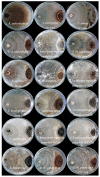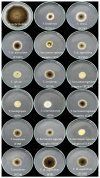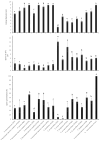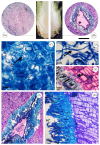Native and Non-Native Soil and Endophytic Trichoderma spp. from Semi-Arid Sisal Fields of Brazil Are Potential Biocontrol Agents for Sisal Bole Rot Disease
- PMID: 39728356
- PMCID: PMC11678323
- DOI: 10.3390/jof10120860
Native and Non-Native Soil and Endophytic Trichoderma spp. from Semi-Arid Sisal Fields of Brazil Are Potential Biocontrol Agents for Sisal Bole Rot Disease
Abstract
Sisal (Agave sisalana) bole rot caused by Aspergillus welwitschiae is the main phytosanitary problem affecting sisal in the Brazilian semi-arid region. The aim of this study was to evaluate Trichoderma spp. as biocontrol agents for sisal bole rot. Native and non-native species, both soil inhabitants and endophytes, and isolated from different plant hosts were tested. Anatomical studies of the interaction among A. sisalana, Trichoderma spp., and A. welwitschiae were performed. T. cf. asperellum (isolate F12), an endophyte of sisal leaves; T. cf. asperellum (TCS83) from banana plant soil; T. lentiforme (TCS15) and T. harzianum (species complex) (TCS35 and TCS76) from sisal root soil; T. spirale (R62) and T. saturnisporum (R75), endophytes of sisal roots, were the most efficient isolates, with inhibition of A. welwitschiae mycelial growth by up to 70%, and inhibition of sporulation and spore germination by 99%. A reduction in disease incidence of 70 to 93% and in disease severity of 97% was achieved. T. lentiforme (TCS1), T. harzianum (species complex) (TCS35 and R72), and T. koningiopsis (R78) showed mycoparasitism. An increase in cell wall thickness of bole tissue colonized by these Trichoderma species indicated that induced plant defense responses occurred, preventing pathogen colonization, which should be further investigated. Native and non-native Trichoderma species can control sisal bole rot disease.
Keywords: Agave sisalana; Aspergillus welwitschiae; Trichoderma cf. asperellum; Trichoderma harzianum (species complex).
Conflict of interest statement
Author Leonardo O. Barbosa was employed by the JCO Bioprodutos Company. The remaining authors declare that the research was conducted in the absence of any commercial or financial relationships that could be construed as a potential conflict of interest.
Figures












References
-
- Nobel P.S. Remarkable Agaves and Cacti. 1st ed. Oxford University Press; New York, NY, USA: 1994. pp. 86–87.
-
- Zizumbo-Villarreal D., González-Zozaya F., Olay-Barrientos A., Platas-Ruíz R., Cuevas-Sagardí M., Almendros-López L., Colunga-GarcíaMarín P. Archaeological evidence of the cultural importance of Agave spp. in pre-Hispanic Colima, Mexico. Econ. Bot. 2009;63:288–302. doi: 10.1007/s12231-009-9092-5. - DOI
-
- Parsons J.R., Darling J.A. Maguey (Agave spp.) utilization in Mesoamerican civilization: A case for precolumbian “Pastoralism”. Bot. Sci. 2000;66:81–91. doi: 10.17129/botsci.1614. - DOI
-
- Nobel P.S. Environmental Biology of Agaves and Cacti. Cambridge University Press; New York, NY, USA: 2003. p. 270.
Grants and funding
LinkOut - more resources
Full Text Sources
Miscellaneous

